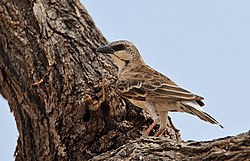| Sparrow-weaver | |
|---|---|
 | |
| White-browed sparrow-weaver, Plocepasser mahali | |
| Scientific classification | |
| Kingdom: | Animalia |
| Phylum: | Chordata |
| Class: | Aves |
| Order: | Passeriformes |
| Family: | Ploceidae |
| Genus: | Plocepasser A. Smith, 1836 |
| Type species | |
| Plocepasser mahali [1] A. Smith, 1836 | |
| Synonyms | |
| |
The sparrow-weavers (Plocepasser) are a genus of birds in the family Ploceidae (weavers), but some taxonomic authorities place them in the family Passeridae (Old World sparrows).



